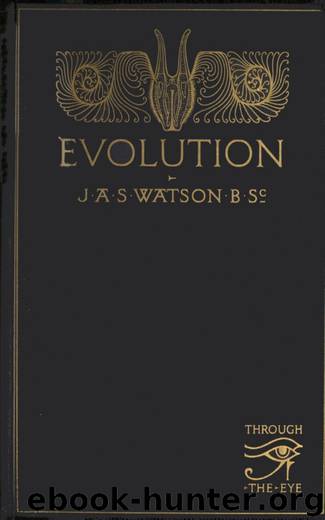Evolution by James A. S. Watson

Author:James A. S. Watson [Watson, James A. S.]
Language: eng
Format: epub
Published: 2016-09-06T22:00:00+00:00
49.—Molluscs—Univalves.
50.—Molluscs—Bivalves.
51.—Molluscs—Cuttle-fish, with eggs.
Our third great group is that of the Arthropods (literally 'jointed footed'), including the Crustaceans (crabs, lobsters, shrimps, etc.), spiders and mites, centipedes and insects. The Arthropods are sometimes classed together with their ancestors, the ringed worms (such as the common earth-worm), as Articulata, a name which refers to a very obvious feature, the repetition of similar segments in a regular series from front to rear. This is perhaps most apparent in the ringed worms and centipedes, but it is to be seen in all members of the group. This same tendency to reduplication of parts in a regular series may be observed in the vertebrates, as we shall see. Slight indications of it are also to be found in the Nemertines. Numerous theories have been proposed which derive the vertebrates from some of the Articulata?from the ringed worms or the Crustaceans, and even from the air-breathing members; and at first sight such theories seem attractive, for in some of their more obvious characters there is a certain resemblance between the two groups. But there are also many and fundamental differences, and few zoologists have accepted any hypothesis of this type. We may briefly allude to some of these differences.
52.
1, Marine swimming ringed worm; 2, giant centipede; 3, Peripatus.
Photo: Martin Duncan, Berridge, and Bastin.
Download
This site does not store any files on its server. We only index and link to content provided by other sites. Please contact the content providers to delete copyright contents if any and email us, we'll remove relevant links or contents immediately.
| Automotive | Engineering |
| Transportation |
Whiskies Galore by Ian Buxton(41879)
Introduction to Aircraft Design (Cambridge Aerospace Series) by John P. Fielding(33064)
Small Unmanned Fixed-wing Aircraft Design by Andrew J. Keane Andras Sobester James P. Scanlan & András Sóbester & James P. Scanlan(32743)
Craft Beer for the Homebrewer by Michael Agnew(18140)
Turbulence by E. J. Noyes(7935)
The Complete Stick Figure Physics Tutorials by Allen Sarah(7307)
Kaplan MCAT General Chemistry Review by Kaplan(6866)
The Thirst by Nesbo Jo(6826)
Bad Blood by John Carreyrou(6552)
Modelling of Convective Heat and Mass Transfer in Rotating Flows by Igor V. Shevchuk(6391)
Learning SQL by Alan Beaulieu(6209)
Weapons of Math Destruction by Cathy O'Neil(6142)
Man-made Catastrophes and Risk Information Concealment by Dmitry Chernov & Didier Sornette(5921)
Digital Minimalism by Cal Newport;(5663)
Life 3.0: Being Human in the Age of Artificial Intelligence by Tegmark Max(5474)
iGen by Jean M. Twenge(5366)
Secrets of Antigravity Propulsion: Tesla, UFOs, and Classified Aerospace Technology by Ph.D. Paul A. Laviolette(5309)
Design of Trajectory Optimization Approach for Space Maneuver Vehicle Skip Entry Problems by Runqi Chai & Al Savvaris & Antonios Tsourdos & Senchun Chai(5011)
Pale Blue Dot by Carl Sagan(4912)
